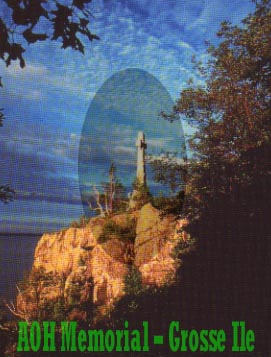Irish Memorial

|

|

|


Though the generosity of French Canadians, orphaned Irish children
were adopted and in many instances allowed to retain their
own surnames.
Books ...
Wild Geese ...
Red Hand ...
French Mention
Children of the Gael died in their thousands on this island having fled from the laws of foreign tyrants and artificial famine in the years 1847-48.
God's blessing on them. Let this monument be a token to their name and honor from the Gaels of America.
God Save Ireland.Translation of the Irish inscription on the Celtic Cross erected by the AOH in 1909.
A translated English version is more politically correct and is markedly softened.
As well as copies of the book, a U.S. edition of which is due for
publication in October, officers also confiscated 160 copies of the
Breglio Report - a report into the January 30, 1972 Bloody Sunday
shootings in County Derry, Northern Ireland, that resulted in the
deaths of 14 unarmed citizens.
The report, compiled by former New York City Police Department ballistics
expert Robert Breglio, alleges that British army snipers, using rifles
and telescopic sights, shot at civil rights protesters from the walls
of Derry.....................
After questioning, Mullen was released and allowed to continue his
journey to Grosse Ile but was not given back the books, reports and
other items.
Informational Linkages
| Hills of Tara | Erin State |
| Quebec Travels | Quebec Pictorials |
| How Irish? | NY Times - a List |
| Thingies | Famine Events |
| Irish News | Irish Net |
| Celtic Culture | Toronto Parade |
| Lark Spirit | Canadian |
The Irish in Newfoundland 1623-1800 by Michael J. McCarthy.
In 1623, Lord Falkland, who planned on founding a colony on the Southern Shore of the Avalon around Renews, had a book published for him in Dublin, inviting Irishmen to participate in a venture.A statement by one of another time.
Newfoundland is a fine plantation, It shall be my station
till I die, Mo Cradh! go m'fhearr liom a bheith a n-Eire,
(Alas! I'd rather be in Ireland)
Donnacadh Ruadh MacConMara (1715-1810)
Irish Halifax: The Immigrant Generation, 1815-1859 by Terence M Punch
1981, is worth reading.
The mass exodus of Irish, which ran from 1815 until the 1850's, had a deep impact on all the North American areas which received the flow of emigrants. One such host community was Halifax, Nova Scotia.
In the fuzzy mind of popular history, the Irish of the new world have been linked to their larger and more "typical" settings, like Boston, New York, and Chicago, and when the drift shifts to Canada, the larger urban concentrations again spring to mind: Halifax, Saint John, Montreal......... By far the greater part of Canada's Irish settlers and the offspring have lived on the fringes of larger alien communities.
Irishman Richard John Uniacke was to cut his teeth in American patriot, Jonathan Eddy's rebellion, although he was later to rise to the position of respected servant of his majesty's government.
Archivist Harvey writes in the Preface:
As a result of this prolonged research more than, one persistant conjecture has been proven wrong. For example, the statement has been made repeatedly that Scottish immigration to Nova Scotia reached its peak in 1817 and ceased abruptly in 1828. ---------------- and from casual references in the Archives that almost as many Scots came to Nova Scotia in the decade subsequent to 1838 as in the previous decade, although more than half of them came between 1839 and 1843. --------------
Similar revisions have been made in the traditional view of Irish immigration, which is shown to have been much greater in this period than was generally suspected.In Appendix III of preparer J.S. Martell's document
On numbers and years shown of Passengers from Newfoundland - 1815-1838
It is not supposed that these are complete returns of "passengers" from Newfoundland to Nova Scotia. ------ Nearly a thousand, perhaps, there were more, came in 1816 and 1817 and it is known that they were Irish. Those at Arichat in 1830 were also Irish. Most of the others were probably Irish.
My comments
In material I've read, it appears the Scots seemed to be
loyal to the Crown even after the defeat they suffered
at Culoden. Maybe that is why American historians play up a
Scot-Irish scenario for a Scot's contribution in America's cause although
Scot John Paul Jones (added Jones to his Paul surname after murdering
a fellow Scot) comes to mind. Nova Scotian, historian A.C. Jost of Guysborough County
compared Jonses' thuggary to that of the German submarines that sank
Cansco fishing schooners during WWI.
Jones' privateering escapades was little more than legalized piracy.
Back then, the Royal Navy's practice of sending ashore cudgel-swinging bands
of sailors, the notorious press gangs, to "impress" males into seagoing
service was legalized kidnapping. When an admiral ran short of a crew,
the governor persuaded his counsel to issue a press warrant, ostensibly
to rid Halifax of vagabonds. Nova Scotians vanished into the lower decks
of His Majesty's ships to die in distant lands, or from scury etc.
Scot-Irish folks had been in Ireland by 100 years as of this point in
time. When does an American born individual become an American or
an English born Irish person become English and British?
Spoke to a gentleman, while I was in
Halifax who brought to my attention that Haligonians with
names appearing to be of an Irish origin wonder about
it. He posited that some of them may have been "soupers,"
those who availed of soup during the Famine and in doing
so became Protestants. Naturally there are many shades of
reasons for recreating the past.
Angelfire - Easiest Free Home
Pages
This document last modified Sep 15, 2001.